Menus
- Retro motorcycles from Kawasaki, Moto Guzzi and Triumph
- Comparison test of retro bikes: Part 2
- Conclusion
- Kawasaki W 800
- Moto Guzzi V7 Classic
- Triumph Bonneville SE
- Kawasaki W1
- Moto Guzzi V7
- Triumph Bonneville T 120
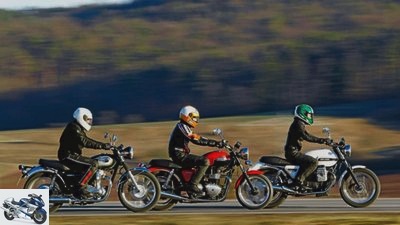
Gargolov
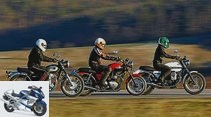

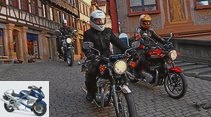

23 photos
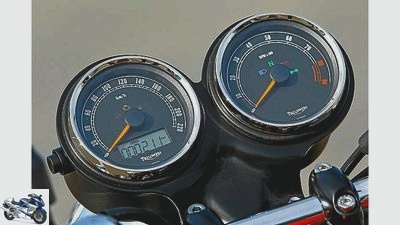
Gargolov
1/23
Chrome, sweet chrome. No-frills round clocks at Triumph.
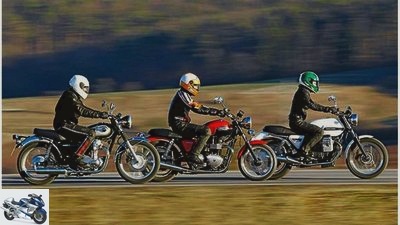
Gargolov
2/23
Comparative test of retro motorcycles – these three beautiful two-cylinder units cite the form and technology of the 1960s: Kawasaki W 800, Triumph Bonneville SE and Moto Guzzi V7 Classic.
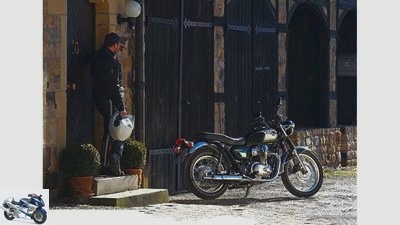
Gargolov
3/23
Kawasaki W 800: Your parallel twin looks almost like a single when viewed from the side.
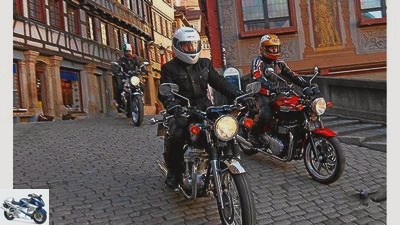
Gargolov
4/23
Out and about in the venerable university town of Tubingen.
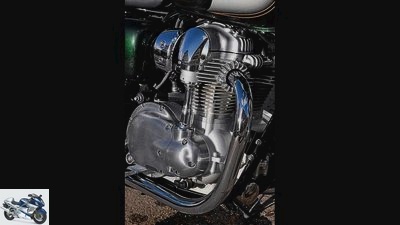
Gargolov
5/23
Nostalgic cooling fins: The cylinders of the Kawasaki W 800 are slim, slim, tall.
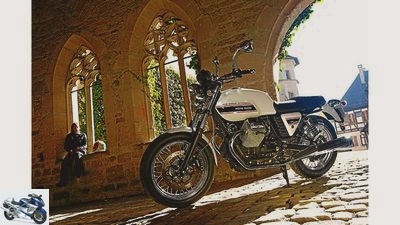
Gargolov
6/23
The flat cylinders of the Moto Guzzi V7 Classic appear angular, angular, and almost square in cross-section.

Gargolov
7/23
The retro motorcycles can also be seen from behind.

Gargolov
8/23
The 90-degree V2 is the brand’s holy grail, and has long been the only engine concept from Moto Guzzi.
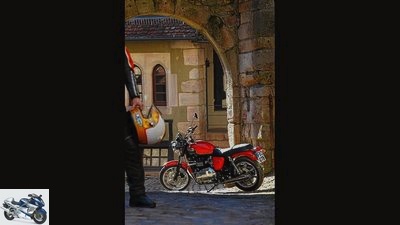
Gargolov
9/23
The twin of the Triumph Bonneville SE is wide, massive and compact.
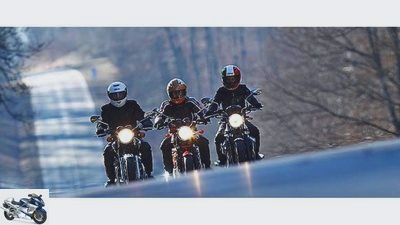
Gargolov
10/23
Retro bikes offer the magic of modern classics.
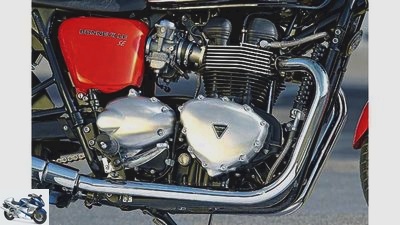
Gargolov
11/23
The mighty engine housing cover of the Bonneville turns on the chain primary drive, it’s real gears.
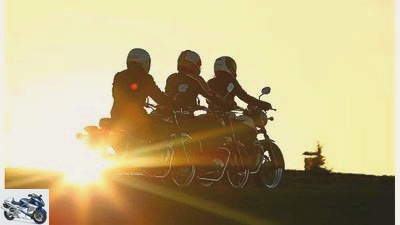
Gargolov
12/23
You want to cruise into the sunset with these motorcycles.
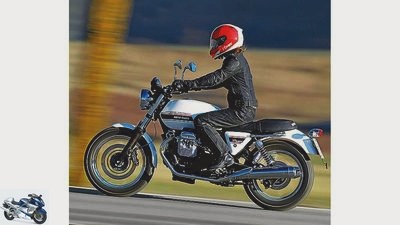
Gargolov
13/23
The Moto Guzzi V7 Classic.

Gargolov
14/23
The Moto Guzzi V7 ushered in the era change to the V2 engine in Mandello in 1967.
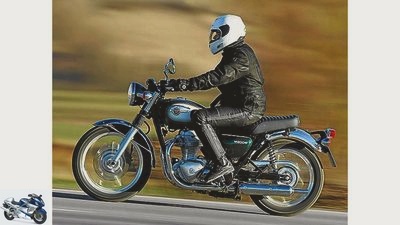
Gargolov
15/23
The Kawasaki W 800.
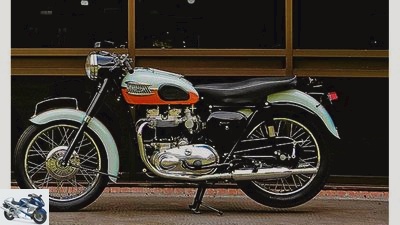
Gargolov
16/23
The Triumph Bonneville T 120 with two-tone paint and double carburetor became an icon.
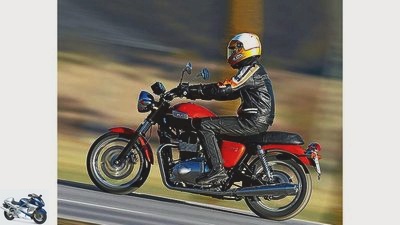
Gargolov
17/23
The Triumph Bonneville SE.
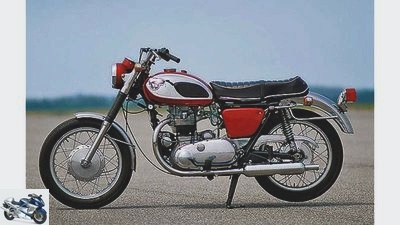
Gargolov
18/23
Copy of a copy: The Kawasaki W1 was based on a Meguro and this on the BSA A7.
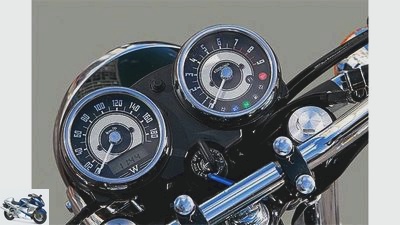
Gargolov
19/23
Kawasaki: No experiments: Classically scaled instruments with digital odometer.
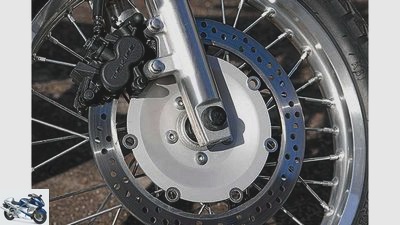
Gargolov
20/23
Unfortunately only a weak front brake on the Kawa.
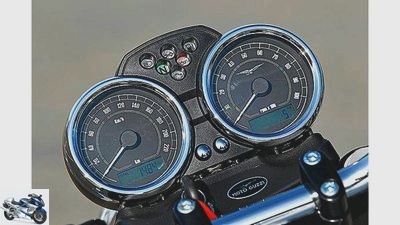
Gargolov
21/23
The cockpit of the Moto Guzzi: Fine needles in beautiful watches.
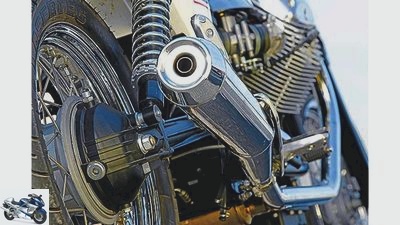
Gargolov
22/23
In the test, the somewhat stubborn response of the shock absorbers on the Moto Guzzi was a problem.
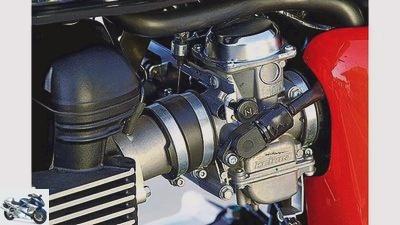
Gargolov
23/23
Triumph: Injectors in carburetor cases are great, Britain.
Comparison test, Kawasaki W 800, Moto Guzzi V7 Classic, Triumph Bonneville
Retro motorcycles from Kawasaki, Moto Guzzi and Triumph
Your future is your past. These three beautiful two-cylinders from Kawasaki, Moto Guzzi and Triumph cite shapes and technology from the 1960s. As feel-good motorcycles inspired by history, they authentically bring the driving experience of a bygone era onto the asphalt.
E.Finally, a sunny, warming day in early spring after this long winter. We, Anna, Anton and the author, eagerly inhale the first kilometers of this season in our home country. We take the fluid, brisk curve combinations on the old B 27 under our wheels with a swing. This 673 kilometer long federal road knows many places and picturesque landscapes from the Swiss border to the Eastern Harz. And yet this one passage is special. Because he is the author’s home track, many memories cling to him. And because it takes us directly to the ensemble of the venerable Bebenhausen monastery near Tubingen, founded in 1187.
Buy complete article
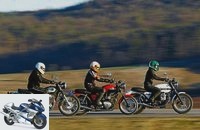
Comparison test
Retro motorcycles from Kawasaki, Moto Guzzi and Triumph
Kawasaki W 800, Moto Guzzi V7 Classic and the Triumph Bonneville SE. They are built according to a traditional pattern and have clear, simple technology: air-cooled two-cylinder engines with five-speed gearboxes in simple knitted chassis with conventional, flat-set telescopic forks. Plenty of chrome jewelry looks wonderfully rustic. Round instruments and tubular handlebars crown the double-loop tubular frame. A matter of honor, made of steel and painted in classic black. The same applies to the two-arm swing arms, which are supported on the left and right by spring struts and in which narrow rear tires rotate.
All motorcycles used to be built this way. Today, three brand-fresh representatives of this type seem to have fallen out of time. They are a stylish alternative to the "higher faster further", that makes the motorcycle market spin faster and faster.
In the wild 1960s, the historical models for these machines were really powerful motorcycles, 40 to 50 hp. Today it takes three to four times the performance. The 48 hp rated power of the V7 and W 800 seem antiquated. Even the 68 hp of the Bonnie seem rather cute. Made, because performance is relative. This trio is good without superlatives "smaller" Machines very much for great emotions. Inspired even while standing.
Gargolov
The royal Kawasaki W 800 with a vertical shaft motor.
Because these popular figures enchant even people without motorcycle enthusiasm. Because taste is a love of beauty – and the aesthetics of these mechanical sculptures are very intuitive: "But they are delightful", says an older lady. Right. Be design or not. A look at the engines reveals different philosophies.
The Kawasaki parallel twin is currently the only series engine with a vertical shaft. Majestic. Visually, the W 800 is based on the 650 Kawasaki W1 from 1966, see page 64. It is a classic straight out of the box, with bellows, knee pads and chrome mudguards. Suitable for everyday use, thanks to the luggage hook and main stand.
In contrast, the Triumph Bonneville SE is said to be the successor to the legendary namesake from 1959. Your name goes down like oil, even after 50 years. Both pistons run up and down in parallel in the modern Triumph Twin. Triumph has been building the new Bonneville since the 2001 season, later bringing the Thruxton and Scrambler based on it. This series "Modern classics" is a homage to the glorious past of the traditional brand.
And with great success. Ten thousand copies made the series the most successful of Triumph by the time the Street Triple was released. In times when it is not easy to bring new motorcycles to men or women.
The assembly of these types takes place completely in the Thai Triumph factory, their processing is solid. Shiny cast wheels give the Bonneville "SE" (Special Edition) 1970s look. Technically sensible because they enable tubeless tires and are lighter. Spoked wheels, as with Kawa and Guzzi, are only offered by the Bonneville T 100 with a 19-inch front wheel and a higher seat.
Gargolov
Magic of modern classics. The Triumph-Twin in Bonneville is wide, massive and compact.
Moto Guzzi only uses 90-degree V2 engines. And quotes timeless motorcycle construction differently. As a classic, traditional motorcycle, the current, crisp white V7 Classic is cheekily copying from various historical ancestors. The paint design of the V7 Spezial from 1969, for example. Triangular side covers and the bulges of the long tank above the cylinders are an homage to the V7 Sport from 1972 and the modular system with the current V7 Cafe Classic. Nonetheless, the mixture, interpreted quite freely, is well received, looks homogeneous as if it were made from one piece, not like a plagiarism. Pragmatic and down-to-earth. The wonderful blue and gold-colored manifolds of the motorcycle provided by the Guzzi specialist baker go perfectly with this.
"Ignition on" answer three whirring petrol pumps. In order to comply with the Euro III emissions standard, injection, G-Kat and electronic engine management are essential. The W 800 therefore had to do without a kick starter – unlike its carburettor-equipped predecessor, the W 650, which was built between 1999 and 2006. Then just electric start. Despite melodious "Peashooter"-The Kawasaki whispers thin exhausts. Anton would like more sound from the low and horizontal pots that cling to the rear wheel: "not necessarily louder, but bassier, fuller".
The Triumph’s ignition lock is hidden on the left headlight bracket. Well, the Triumph roadster bags also sound rather poor, inconspicuous, like a Honda CB 400 N in the 80s. The Guzzi-V2 announces the combustion engine experience differently. It drowns out the other two, hums comfortably, gasps for intake air, stamps and trembles. Goosebumps are guaranteed. Well, in the urban canyons of the medieval town, the pithy sound charisma is almost too much of a good thing. Especially since you need a little gas and cold start aid ("choke") has to play, the V2 likes to go out again.
The back torque is funny, due to the lengthways crankshaft: When accelerating while stationary, the V7 first turns to the right and then to the left. Starting off requires some strength in the left forearm. The clutch acts tighter than on the Kawa and Triumph, the lever sticks out far. But only on the Bonnie and W 800 are the hand levers adjustable. The shifting travel of the hacky, not particularly easy to shift Guzzi transmission is long.
You almost have to step into first gear. The compact Italian could actually make it the easiest for beginners to get going, as she is the lightest of the group at 210 kilograms. If it weren’t for these little nicknames. The slight steering angle makes maneuvering difficult and the turning circle is large.
Comparison test of retro bikes: Part 2
Gargolov
Out and about in the venerable university town of Tubingen.
Uff. The wide cut of the motorcycle waist requires long legs despite the low 75 centimeter seat height. Anna is small and only gets her toes on the ground. The knees park a bit oddly on the narrow tank, directly on the cylinders. The 744 cm3 Guzzi engine, which has a real capacity of just 46 hp and measures 744 cm3, offers high entertainment value. It accelerates better than the 33 cm3 larger Kawasaki and keeps the Bonnie in check when it pulls through. Respect. The clean, low-reaction cardan drive is positive.
The Guzzi engine pulsates with a pleasantly low frequency. "Good vibrations." The W 800 works a little differently, more smoothly. After a cold start, it takes a while for the electronics to steadily raise the idle speed into four-digit ranges. But then, in contrast to the more leisurely, slower revs, it never drops below 1000 rpm. Just fine, how the eight-valve drive bubbles up from the speed basement.
However, the 650 twin came across with a longer stroke. No wonder, because Kawasaki only increased its bore and thus came to 773 cm3. But the plus in torque (not in top performance!) Also resulted in reduced revving. Mechanical expressions of life of the parallel twin are always a little present, but never annoying because of the balance shaft. The pace of wellbeing is the same as with Guzzi and Triumph: 80 to a maximum of 120.
The stylish Japanese lets herself be conducted in a playful manner. How easy motorcycling can be. Even beginners can get along well with the Kawasaki, which weighs 217 kilograms. In spite of the highest seat height of 81 centimeters: the quilted, slightly stepped bench is cut nice and narrow in the front area. Historically correct, one sits upright and lofty. The 800 falls wonderfully easily in an inclined position and always remains neutral there.
She conveys a lot of trust. And even when it comes to tires, it’s historically most accurate, rolling on large wheels, 19 inches at the front and 18 at the rear. The beautiful Dunlop Roadmasters adhere really well. They look like they were already rotating in the 60s. Consistent down to the last detail.
Gargolov
The Guzzi is particularly strong in sound and character.
The Kawasaki’s footrests are the first to come into contact with the asphalt. Be that as it may, the W 800 automatically drives gently and comfortably, it decelerates. The suspension elements are designed to be comfortable, the suspension struts are lax because they are soft and underdamped. The delay is very defensive; the disc at the front needs conviction, a lot of hand strength, and takes a bite, the drum at the back brakes as it once did, moderately powerful, properly metered.
The agile Guzzi drives cheekily, swings lightly, relaxed and carefree through life. Almost sporty. Your footrests, which are placed quite high and at the front, touch down the latest. It’s a shame that their cross-ply tires, Metzeler Lasertec, don’t stick well, Bridgestone BT 45 would be the better choice. The stereo struts respond a bit in a mess and are not particularly comfortable.
The brake issue is only taken seriously in Mandello, using the V7’s four-piston fixed caliper as a stopper on the 18-inch front wheel. Retro or not, an ABS option would also look good on neo-classics. The Triumph driver sits casually 74 centimeters above the ground. Even women of graceful build get both feet on the ground when stopping here.
For tall guys, the arrangement with the cranked handlebars can be too compact. Some bottoms also find the bench a tad too hard. The English Thai woman drives flawlessly, simply great. The 865 cubic king of the trio pulls in with no holes in the engine speed range. It is the only motor that can even begin to stretch your arms and let the speedometer needle tickle the 200. And always keep a cool head because of the oil cooler. The injection is fine-tuned, the four-valve engine is tightly attached to the gas.
Gargolov
With the three retro bikes you can move around the city in style.
Bonnie, who weighs 227 kilograms, easily drives the other two up and away. Only at the top does the propulsion, which had been good up to then, wan, does the Triumph Twin feel a bit tougher. The fact that it sends the thickest pistons, full 90s, to the shortest stroke, costs it a little of the promised classic character. Also applies to two balancer shafts. It all seems a little softened. While the W 800 drives as authentically as it used to, the Triumph does more than pretend to be. In a good way too, with injection nozzles in carburetor housings. The Bonnie takes her course with absolute serenity, almost automatically steering into the curves. Tighter arcs, wider radii? Whatever you choose, corrections are no problem. Handling that inspires. Downside? Okay, the slightly aged Metzeler steel belted tires Z4 Front and Z4 on the 17-inch front and rear (style break!) Need temperature to build up reasonable grip. Furthermore, the suspension struts with the shortest spring travel are a touch drier, more crisp than those of the W 800 in this comparison. But this fits in with the sportier character. Until March 31, 2011, every Bonneville comes with a free sporty seat, chrome grab handle and main stand worth a total of 620 euros. Good thing because the Bonnie SE costs a proud 9340 euros in a two-tone dress. The cheapest is the Kawasaki for 8,360 euros, for the Guzzi 8,645 euros.
The day has become long. It is already getting dark and getting dark quickly. All three cast light from classic-looking plastic lamp housings – it cannot rust. They are completely chrome-plated at Guzzi and Triumph, with a painted lamp pot at Kawa. It relies on traditional lighting technology, while V7 and Bonnie wear brightly shining multi-reflector inlays. What is more contemporary? Real experiences beckon in every tunnel, under every lantern. When the highlights of the big city are reflected in the chrome-plated instrument rings, dance once in a circle and then burn up in fork plugs or indicator housings, that’s great cinema.
It is an art to create beauty. In this respect, these beautiful, fine motorcycles enrich the world, like paintings and good music. As a bridge between yesterday and today. Grace, lust for life and joy – that’s what the three rolling time machines stand for. In a story that only knows winners. Because life is too short to ride ugly motorcycles.
Conclusion
Gargolov
The three are wonderful: Kawasaki W 800, Triumph Bonneville SE and Moto Guzzi V7 Classic.
Kawasaki W 800
A balanced character, predestined for calmer minds. Although the long-stroke experience with the W 650 was even more pearly: The W 800 with its original English appearance is the most authentic way of driving a reliable, factory-fresh vintage car.
Moto Guzzi V7 Classic
The lightest motorcycle in the field is particularly sensual, full of sound and character. And with the best brakes. The rather weak V7 offers a great experience. Nobody needs more motorcycles to ride in style and casual.
Triumph Bonneville SE
Ennobled by one of the most illustrious names in motorcycle history, the Triumph alone fulfills the demands for somewhat contemporary propulsion. When it comes to feeling in motion, however, Bonnie has to line up behind the other two.
Kawasaki W 800
Gargolov
For those who are nostalgic for cooling fins: the cylinders of the Kawasaki are slim, slim and tall. Your parallel twin looks almost like a single when viewed from the side. Its vertical shaft is absolutely exclusive: its bevel / crown gears transmit the rotary motion of the crankshaft to the central, overhead camshaft.
engine:
Air-cooled two-cylinder four-stroke in-line engine, a balancer shaft, an overhead camshaft driven by a bevel shaft, four valves per cylinder, rocker arm, wet sump lubrication, injection, Ø 34 mm, regulated catalytic converter with secondary air system, alternator 252 W, battery 12 V / 12 Ah, mechanically operated multiple discs – Oil bath clutch, five-speed gearbox, O-ring chain, secondary ratio 40:17.
Bore x stroke 77.0 x 83.0 mm
Displacement 773 cc
rated capacity 35.0 kW (48 hp) at 6500 rpm
Max. Torque 60 Nm at 2500 rpm
landing gear:
Double loop frame made of steel, telescopic fork, Ø 39 mm, two-arm swing arm made of steel, two spring struts, adjustable spring base, front disc brake, Ø 300 mm, double-piston floating caliper, rear drum brake, Ø 160 mm.
Spoked wheels with aluminum rims 2.15 x 19; 2.75 x 18
Tires 100 / 90-19; 130 / 80-18
Mass and weight:
Wheelbase 1465 mm, steering head angle 63.0 degrees, caster 108 mm, spring travel f / h 130/106 mm, seat height 810 mm, weight with a full tank * 217 kg, load 183 kg, tank capacity 14.0 liters.
guarantee two years
Colours Dark green metallic
Price / additional costs 8190/170 euros
Moto Guzzi V7 Classic
Gargolov
The 90-degree V2 is the brand’s holy grail, and has long been the only engine concept from Moto Guzzi – 90 years after the factory was founded and 44 years after the V7 as the first V-Zwo model from the Mandello del Lario brand. The flat cylinders of the V7 Classic appear angular, angular, almost square in cross-section, with an underneath camshaft, bumpers and here only two valves per combustion chamber.
engine:
Air-cooled two-cylinder, four-stroke 90-degree V-engine, an underneath, chain-driven camshaft, two valves per cylinder, bucket tappets, bumpers, rocker arms, wet sump lubrication, injection, Ø 36 mm, regulated catalytic converter, 350 W alternator, 12 V / 14 battery Ah, mechanically operated single-plate dry clutch, five-speed gearbox, cardan shaft, secondary ratio 4.125.
Bore x stroke 80.0 x 74.0 mm
Displacement 744 cc
rated capacity 35.5 kW (48 hp) at 6800 rpm
Max. Torque 58 Nm at 3200 rpm
landing gear:
Double loop frame made of steel, telescopic fork, Ø 40 mm, two-arm swing arm made of steel, two spring struts, adjustable spring base, front disc brake, Ø 320 mm, four-piston fixed caliper, rear disc brake, Ø 260 mm, double-piston floating caliper.
Spoked wheels with steel rims 2.50 x 18; 3.50 x 17
Tires 110 / 90-18; 130 / 80-17
Mass and weight:
Wheelbase 1449 mm, steering head angle 62.5 degrees, caster 109 mm, suspension travel f / h 130/118 mm, seat height * 750 mm, weight with a full tank * 210 kg, payload 191 kg, tank capacity 17.0 liters.
guarantee two years
Colours White black
Price / additional costs 8390/255 euros
Triumph Bonneville SE
Gargolov
Magic of modern classics. The Triumph-Twin is wide, bulky and compact. Historical forms, large in size. The synchronous machine imitates two polished case covers on the right that were built up to 1962 "Pre-unit models" with separate gear. On the left, the mighty engine housing cover turns on the chain primary drive, it’s real gears.
engine:
Air-cooled two-cylinder four-stroke in-line engine, two balance shafts, two overhead, chain-driven camshafts, four valves per cylinder, bucket tappets, wet sump lubrication, injection, Ø 37 mm, regulated catalytic converter with secondary air system, 312 W alternator, 12 V / 10 Ah battery, mechanically operated multiple discs – Oil bath clutch, five-speed gearbox, X-ring chain, secondary ratio 43:18.
Bore x stroke 90.0 x 68.0 mm
Displacement 865 cc
rated capacity 50.0 kW (68 hp) at 7500 rpm
Max. Torque 69 Nm at 5800 rpm
landing gear:
Double loop frame made of steel, telescopic fork, Ø 41 mm, two-arm swing arm made of steel, two spring struts, adjustable spring base, front disc brake, Ø 310 mm, double-piston floating caliper, rear disc brake, Ø 255 mm, double-piston floating caliper.
Cast aluminum wheels 2.50 x 17; 3.50 x 17
110/70 R 17 tires; 130/80 R 17
Mass and weight:
Wheelbase 1454 mm, steering head angle 63.0 degrees, caster 106 mm, spring travel f / h 120/100 mm, seat height * 740 mm, weight with a full tank * 227 kg, load 203 kg, tank capacity 16.0 liters.
guarantee two years
Colours Blue / white, orange / black, black
Price / additional costs from 8790/350 euros
Gargolov
The performance diagram of the three retro bikes.
A displacement of around 100 cubic meters means that the Bonnie is in a higher league in terms of power and performance. Only occasionally, at 2500 and 4300 tours, does the W 800 come close to the torque level of the Triumph Twin. But low compression and large centrifugal mass make the Kawa a little phlegmatic, its propulsion slows down first. The V7 is more easy to turn after a small trailer at 4000 rpm. Its 17 liter tank gives the Guzzi the longest range, 378 kilometers.
Maximum speed (manufacturer information):
| Manufacturer | Km / h | Kawasaki | 170 |
| Moto Guzzi | 155 | triumph | 200 |
Acceleration:
| Manufacturer |
60-100 km / h |
100-140 km / h |
Kawasaki |
6.1 | 13.3 |
| Moto Guzzi |
6.0 | 12.8 | triumph |
4.5 | 9.1 |
Draft:
| Manufacturer | 60-100 km / h | 100-140 km / h | 140-180 km / h (sec) | Kawasaki | 6.6 | 9.8 | – |
| Moto Guzzi | 5.7 | 7.1 | – | triumph | 5.5 | 7.6 | 15.0 |
Fuel consumption (country road):
| Manufacturer |
Liters / 100 km |
Kawasaki |
Normal 4.4 |
| Moto Guzzi |
Normal 4.5 | triumph |
Normal 4.4 |
Theoretical range (country road):
| Manufacturer |
Km |
Kawasaki |
318 |
| Moto Guzzi |
378 | triumph |
364 |
Kawasaki W1
archive
Copy of a copy: The Kawasaki W1 was based on a Meguro and this on the BSA A7.
Kawasaki’s W 800 brings a breath of fresh air into a motorcycle division inspired by tradition. A look at the respective ancestral galleries helps to understand this. After Kawasaki had taken over the oldest Japanese motorcycle manufacturer Meguro in the early 1960s, the construction of the Meguro twin K1 Stamina came to Kawasaki. It was a copy of the 500 BSA A7. This resulted in the Kawasaki 650 W1 with 624 cm3 and 47 hp, without any vertical shaft. It was presented for the 1966 season and was similar to the BSA A10. As a W2, it made up to 53 hp with twin carburettors!
Moto Guzzi V7
archive
The Moto Guzzi V7 ushered in the era change to the V2 engine in Mandello in 1967.
When it was launched in 1967, the V7 was an important pillar for Moto Guzzi in order to survive the severe crisis of the Italian two-wheeler market. It was the first motorcycle with the 90-degree V2 concept and longitudinal crankshaft developed by Guzzi engineer Giulio Cesare Carcano. Moto Guzzi sticks to this with a single engine to this day. The V7 had 704 cubic capacity, with the same 80 mm bore as the current V7 models. At that time, 42 hp was not at all modest, but rather the hallmark of a real big bike. Cardan drive and four-speed gearbox were other features of the V7.
Triumph Bonneville T 120
archive
The Triumph Bonneville T 120 with two-tone paintwork and twin carburetors became an icon.
The first Triumph Bonneville T 120 was de facto a works racing machine in 1959. It debuted as a power variant of the successful Tiger T 110, with double Amal carburetor and reinforced crankshaft. T 120 stood for a promised 120 miles per hour, insane 193 km / h. This made the 46 hp Bonnie a legend. It saw itself as a commercial offshoot of the 650 triumph, with which the Texan Johnny Allen had achieved a world speed record in 1956 on the salt lake near Bonneville in the US state of Utah, an incredible 345.20 km / h.
Related articles
-
Projects from BMW and Moto Guzzi, Triumph Erlkonige
Lehmann Projects from BMW and Moto Guzzi, Triumph Erlkonige Winter blossoms The 2007 motorcycle vintage is already sprouting and blossoming. Still hidden…
-
35 pictures 1/35 picture gallery: Triumph Bonneville T100 Black, Moto Guzzi V9 Roamer and Harley-Davidson Sportster 883 Iron in …
-
BMW, Kawasaki, Triumph and Yamaha Tourer in comparison test
Gargolov 31 pictures Gargolov 1/31 Tourer comparison test: Triumph Trophy SE, BMW R 1200 RT, BMW K 1600 GT, Yamaha FJR 1300 and Kawasaki 1400 GT. Gargolov …
-
Gargolov 50 pictures Gargolov 1/50 The Yamaha XV 1900 A Midnight Star is the only one to brake without ABS, but with a composite system. Gargolov 2/50 Sometimes …
-
Moto Guzzi V9 Roamer and Triumph Street Twin
Arturo Rivas 26 pictures Arturo Rivas 1/26 Impression Moto Guzzi V9 Roamer, Triumph Street Twin. Arturo Rivas 2/26 Impression Moto Guzzi V9 Roamer, Triumph …
-
Comparison test of two-cylinder: Ducati 750 Sport, Laverda 750 SF and Moto Guzzi 750 S
29 pictures 1/29 Twin and away: The Ducati 750 Sport, Laverda 750 SF and Moto Guzzi 750 S in a comparison test. 2/29 Your …
-
fact test Moto Guzzi MGS-01 Corsa Please copy it! Moto Guzzi dealer Hokenschnieder has done it: He brings the racing Guzzi MGS-01 Corsa to the …
-
Ducati Scrambler Classic, Moto Guzzi V7 II Scrambler and Triumph Scrambler in comparison test
34 pictures 1/34 The predecessors of Enduros at the time, the current Scramblers are at first glance little more than …
-
Comparison test of show bikes: Bimota Mantra, Moto Guzzi Centauro and Triumph Speed Triple
Comparison test show bikes: Bimota Mantra, Moto Guzzi Centauro and Triumph Speed Triple The onlookers Don’t be too humble. Why …
-
Rossen Gargolov 33 pictures r-photography.info 1/33 Harley-Davidson Sportster 1200 Custom, Moto Guzzi V9 Bobber and Triumph Bonneville Bobber – Cruiser for …